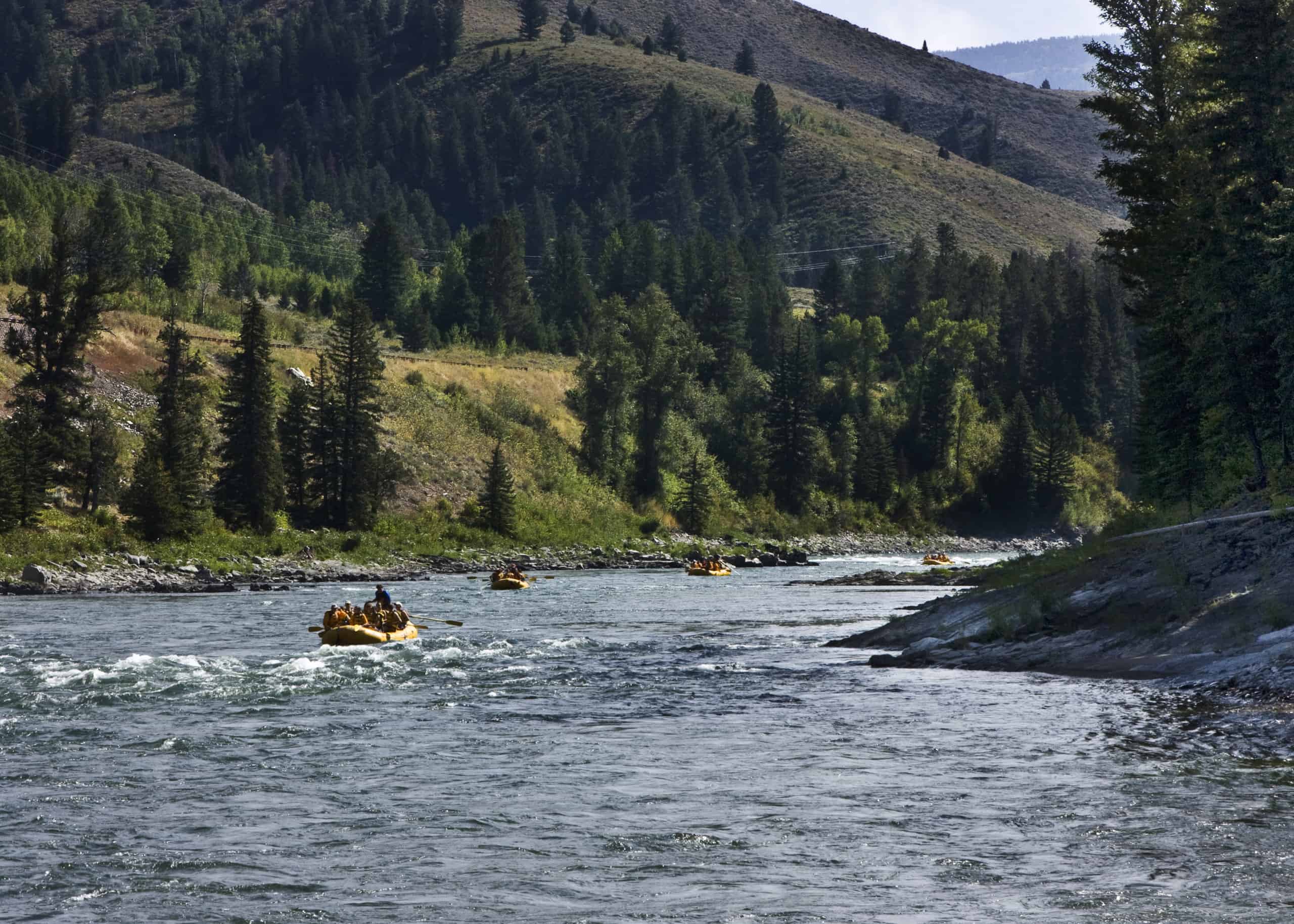Yellowstone National Park is one of the most popular places to visit in the United States. It is home to amazing wildlife and breathtaking views of the natural world. Whether you like to hike, raft, or just enjoy nature, there’s something for you to do in Yellowstone. If you are visiting one of the picturesque rivers in the park, watch for snakes. Like most wildlife, snakes don’t want to get too close to people unless they feel threatened and tend to leave visitors alone who give them their space. By following some sensible guidelines, you can spot snakes in the rivers of Yellowstone when you visit.
Water Snakes in Yellowstone
While all snakes are capable of swimming, there are a few species in Yellowstone that seem to prefer the water. Yellowstone is home to five snake species and three of these are at home in the many lakes, streams, and rivers in the park.
There are not any water snakes that go by that name but there are still snakes that like the water. These include prairie rattlesnakes, rubber boas, and common garter snakes. If you see a snake in the water, it is most likely to be a common garter snake. Prairie rattlesnakes also make frequent appearances, although they aren’t aggressive and tend to leave people alone. Rubber boas are the least common, at least seen by human visitors.
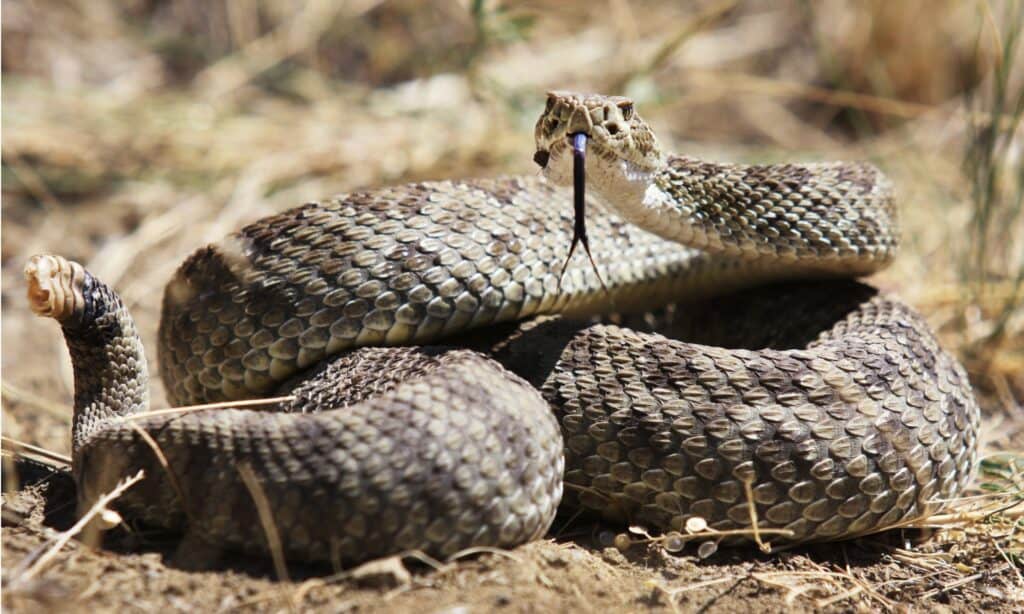
Prairie rattlesnakes (Crotalus viridis) are also sometimes called western rattlesnakes.
©iStock.com/HRossD
While you should always take care when swimming in lakes, rivers, and streams, there are still plenty of places that are safe for swimming in Yellowstone. You can only get in the water in designated areas. This preserves the habitat for wildlife while also keeping visitors safe. Rivers, streams, and lakes in Yellowstone can be freezing cold (hypothermia risk) or above the boiling point and everything in between. By following posted regulations and doing a bit of research ahead of your visit, you can enjoy swimming spots in the park.
Prairie rattlesnakes are the only venomous snake species in Yellowstone. They are also very capable swimmers and frequent bodies of water in the park. Rubber boas and common garter snakes are not venomous and don’t pose much of a threat to human swimmers.
The other snakes in the park include bullsnakes and terrestrial garter snakes. These species can also swim and may even sun themselves on the rocks near bodies of water. They tend not to get in the water to swim, but it is still possible to see them in one of Yellowstone’s rivers, streams, or lakes. Bullsnakes are the largest of the snakes in Yellowstone, making them a bit easier to spot. They can make sounds similar to a rattlesnake, but they are not venomous.

Garter snakes have stripes that run the length of its body.
©iStock.com/randimal
5 Most Snake-Infested Rivers in Yellowstone
#1 Yellowstone River
The Yellowstone River is one of the largest rivers in Yellowstone National Park, so it makes sense that it would have its share of snake residents. The river begins outside of Yellowstone in Wyoming. It enters the park and flows through to Montana and eventually joins the Missouri River in North Dakota.
All five snakes found in Yellowstone can be found in and around the Yellowstone River. The prairie rattlesnake is more common in the lower parts of the river. This is the drier and warmer section of the park, two things that these snakes like when they aren’t taking a dip in the water.
Common garter snakes are some of the easiest to identify as they swim in the water. They have a pair of stripes that run along their bodies, from head to tail. They are some of the most common snakes throughout the U.S. This includes Yellowstone, so expect to see one at least once during your visit. They like water but they are just as comfortable in fields and forests.

The Yellowstone River is home to many interesting animals, including snakes.
©Cavan-Images/Shutterstock.com
#2 Snake River
This river is named for the Native American Snake tribe not because it is overrun with snakes. But you can expect to see some slithering friends in its waters if you visit. The Snake River is over 1,000 miles long but only a small portion (42 miles to be exact) is in Yellowstone National Park. The river originates in the park, then flows into the Columbia River and eventually to the Pacific Ocean. It is a major tributary of the Columbia River.
There are numerous species of wildlife in the river, including snakes. Rubber boas are the most infrequently seen. They like to burrow and are more active at night when the park’s human explorers are not as active. If you do see a snake with a smooth, rubbery exterior, it might just be an elusive rubber boa. When walking near rivers like the Snake River, watch for piles of leaves or other debris. It may just be hiding a rubber boa. These snakes also favor rocks by streams and rivers.
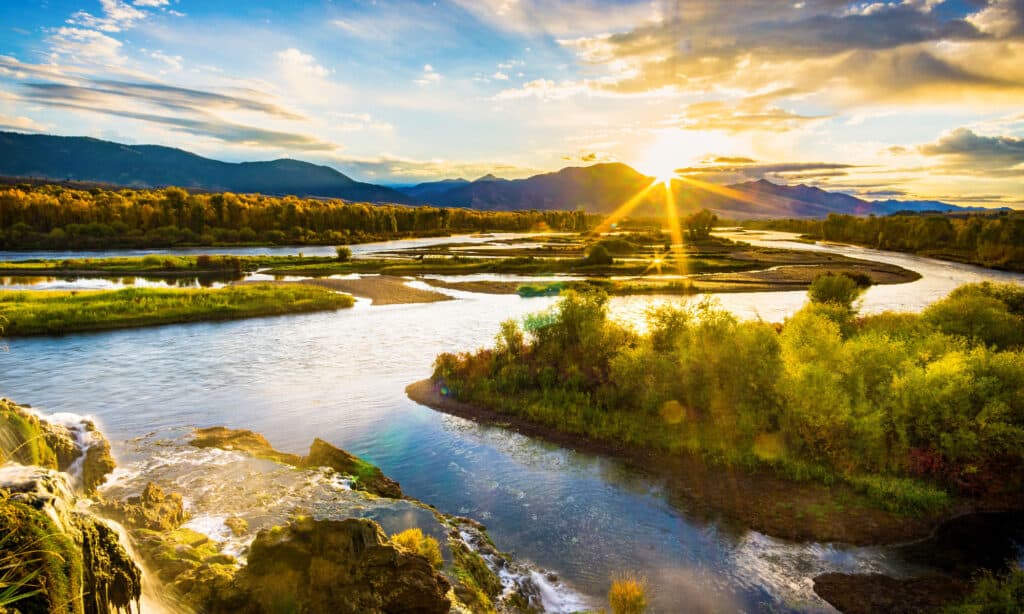
The Snake River flows through Wyoming, Idaho, and Oregon, and joins the Columbia River in Washington.
©Barry Bjork/Shutterstock.com
#3 Lamar River
This river is a tributary of the Yellowstone River and one of many rivers that flow through Yellowstone National Park. Many of the snakes (and other wildlife) in the Yellowstone River are also happy in the Lamar River. It is just over 40 miles long and located completely within the park. The borders of Yellowstone were actually adjusted to include more of the watershed area feeding the Lamar River. This ensured protection for the wildlife and habitat.
Snakes in this river include prairie rattlesnakes, common garter snakes, and sometimes rubber boas. It is located on the eastern side of the park. Common garter snakes are more active in this part of the park than other species. It is also a great spot for other wildlife viewing, although some of these other species can cause snakes to be less interested in sticking around.
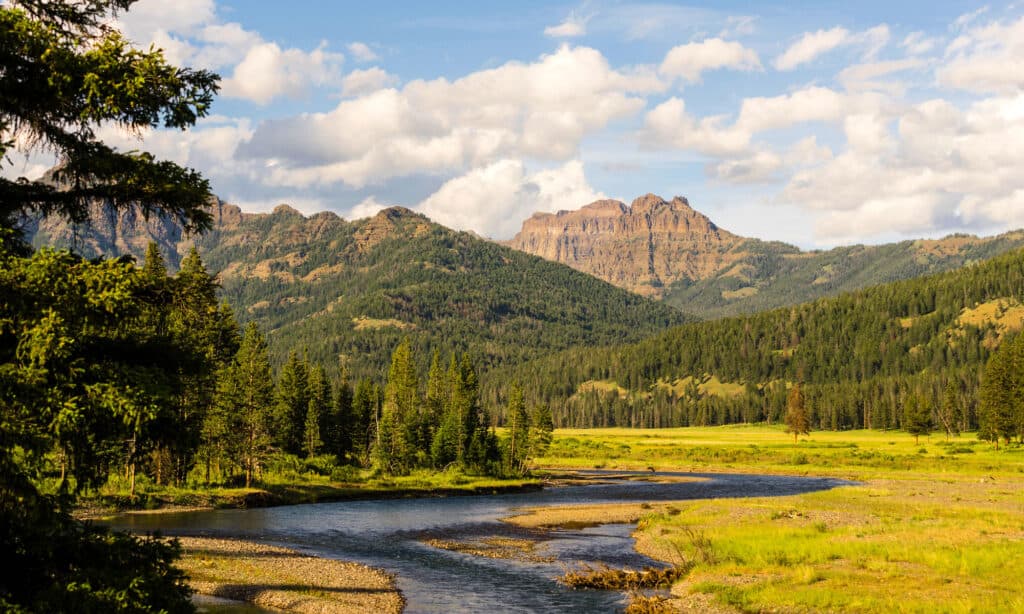
The Lamar Valley holds a river of the same name in Yellowstone, Wyoming
©Real Window Creative/Shutterstock.com
#4 Firehole River
This river flows into the Madison River and eventually becomes part of the mighty Missouri River, which flows into the Gulf of Mexico. The Firehole River is home to one of the few places to swim in Yellowstone. Because you can take a dip in the water, you may be more likely to encounter a snake in this river.
Snakes in the Firehole River include the same species found elsewhere in the park. The two main species you’ll find are prairie rattlesnakes and common garter snakes. Rubber boas are also present but elusive.

Because Firehole River receives drainage from thermal geysers like Old Faithful, the water is heated well.
©Harry Beugelink/Shutterstock.com
#5 Gibbon River
This river is a tributary of the Madison River, just like the Firehole River. It includes twists and turns of rapids, which can make wildlife spotting tricky. But the nearby Gibbon Meadows is one of the more recent locations of the rubber boa. These snakes are not seen often because they are primarily nocturnal. They can also be on the smaller side, just 28 inches long at the maximum length. They are dark brown and blend in well with their surroundings. When someone spots a rubber boa, it is quite an event!

Gibbon Falls in Yellowstone National Park
©iStock.com/David Arment
Summary of the Most Snake-Infested Rivers in Yellowstone
| # | River | Snakes Found |
| 1 | Yellowstone River | Common garter snake, prairie rattlesnake, rubber boa |
| 2 | Snake River | Common garter snake, prairie rattlesnake, rubber boa |
| 3 | Lamar River | Common garter snake, prairie rattlesnake, rubber boa |
| 4 | Firehole River | Common garter snake, prairie rattlesnake, rubber boa |
| 5 | Gibbon River | Common garter snake, prairie rattlesnake, rubber boa |
Other Animals Found in Yellowstone
Any visit to Yellowstone National Park must include wildlife watching. Not only is the park home to amazing species, it has a diverse climate and ecosystem that provides a safe home for many of these species.
Bison
Yellowstone is home to many bison. In fact, Wyoming has a bison on its state flag. These animals almost went extinct but conservation efforts, including creating parks like Yellowstone for them to live safely undisturbed, have increased the population. There are two primary herds in Yellowstone, one in the northern part of the park and the other in the central area. They number around 5,900 bison in total.
Similar species include elk, moose, deer, and mountain sheep. They eat many of the same plants as bison and can coexist within Yellowstone.
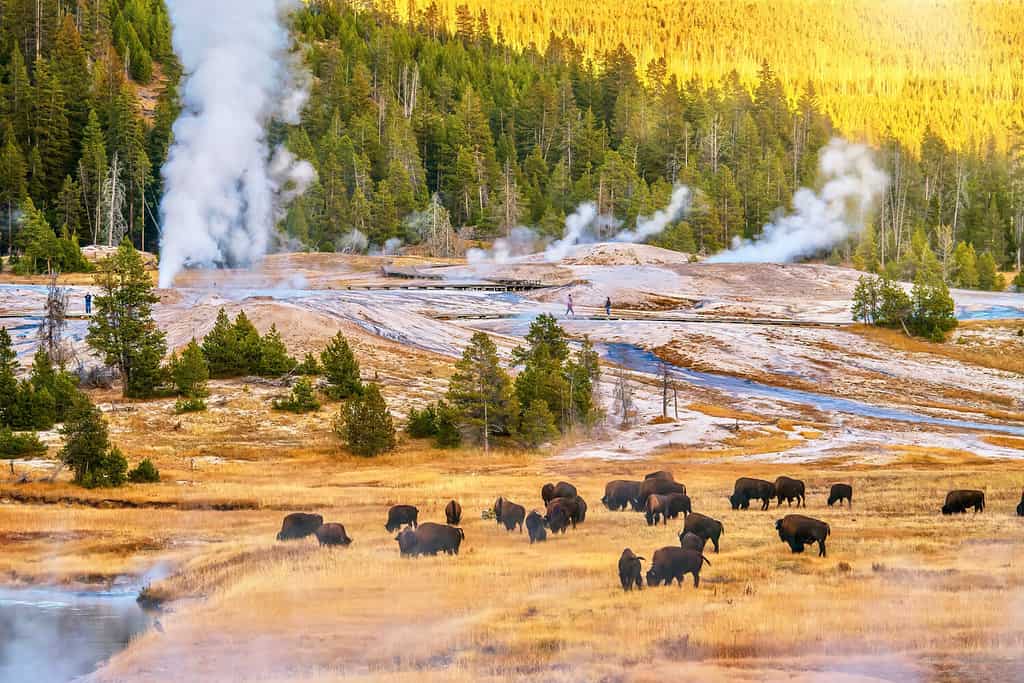
A sunset landscape at the Upper Geyser Basin in Yellowstone National Park, where steam rises from geyser vents and hot springs near a forest of lodgepole pine trees, and a herd of bison is grazing.
©CherylRamalho/Shutterstock.com
Grizzly bears and black bears
Yellowstone is home to both the North American Brown Bear, also known as the grizzly bear, and the North American Black Bear. Grizzlies are much larger and have a much smaller range within the United States. Population estimates put the grizzly population in Yellowstone around 1,000, although not all of these bears stay exclusively in the park’s boundaries. Conservation efforts to help grizzly bears are strong. Black bears are more common. It’s important to give both kinds of bears their space. The law requires that all visitors stay at least 100 feet away.

Yellowstone grizzly bears can be at their most dangerous when they first emerge from hibernation.
©Paul Knowles/Shutterstock.com
Beavers
There are plenty of beavers in Yellowstone National Park. If you are hanging out near rivers or other bodies of water, you’re more likely to come across a beaver. There are around 108 colonies of beaver within the park. The Yellowstone River and Lamar River tend to have more beaver activity than others. Beavers aren’t very aggressive but they can get territorial, especially with other beavers. One of the best things you can do to get a good view is to just spot a beaver dam and wait for them to make an appearance.
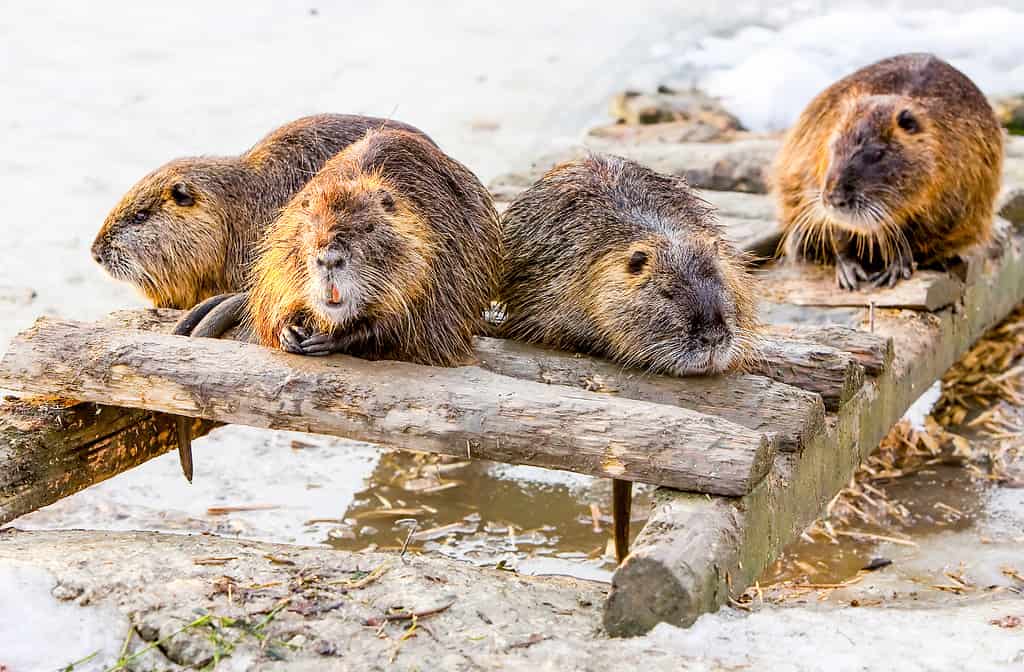
A group of beavers is called a colony.
©Ammit Jack/Shutterstock.com
Yellowstone Cutthroat Trout
This native species is important to the ecosystems in Yellowstone. You’re likely to see it, as well as other species of trout, in the many lakes and rivers in the park. The Lamar River area is important to the conservation of Yellowstone cutthroat trout because many of the non-native rainbow trout upstream have spawned with Yellowstone cutthroat trout. This resulted in hybrid species and declining numbers of Yellowstone cutthroat trout. If you catch rainbow trout upstream of Knowles Falls, regulations require that you kill it to help manage the population.
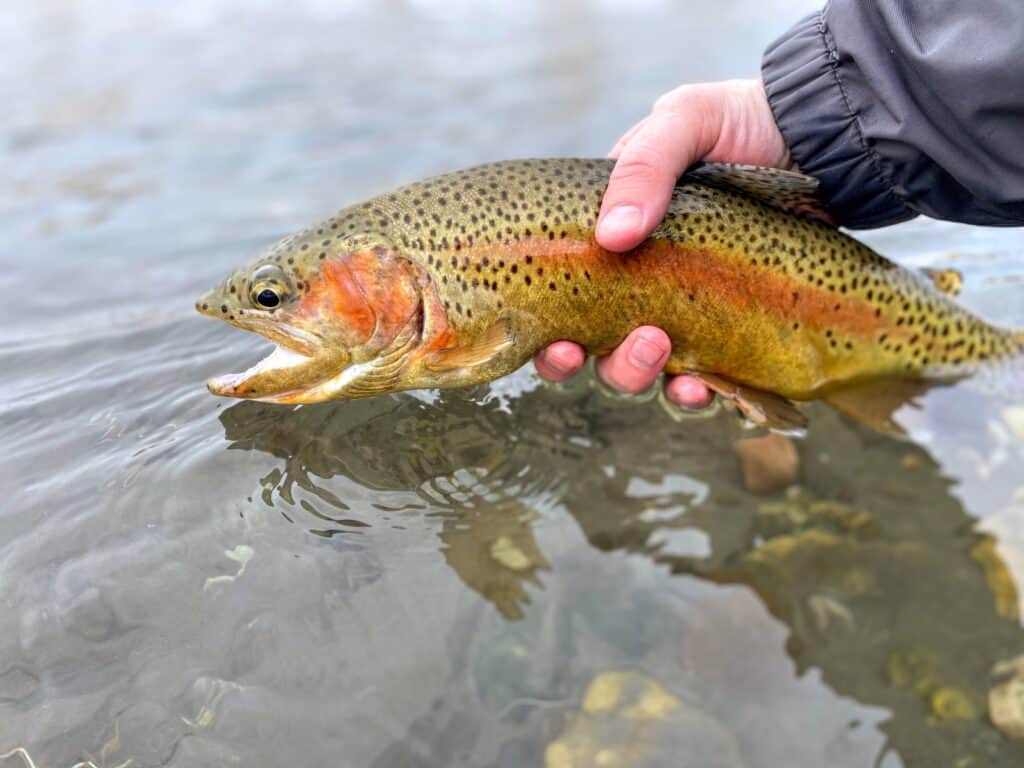
Cutthroat trout can be a variety of colors. Green, gold, and gray are typically the most prominent hues.
©Ryan Cuddy/Shutterstock.com
Thank you for reading! Have some feedback for us? Contact the AZ Animals editorial team.

